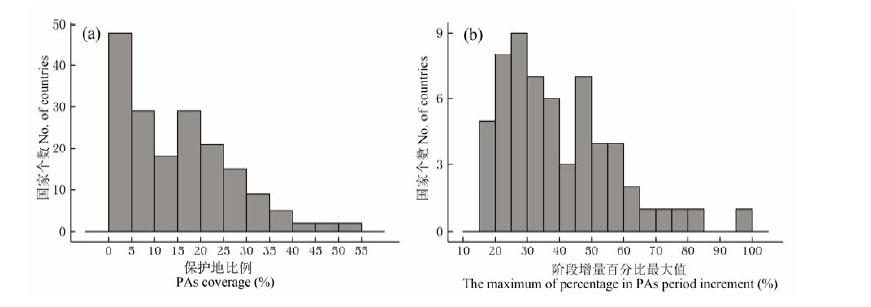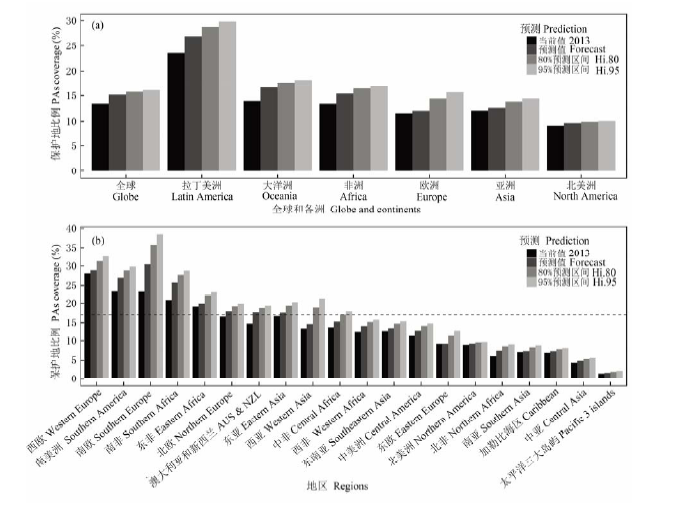



Biodiv Sci ›› 2015, Vol. 23 ›› Issue (4): 507-518. DOI: 10.17520/biods.2015046 cstr: 32101.14.biods.2015046
• Original Papers: Protected Area • Previous Articles Next Articles
Received:2015-02-27
Accepted:2015-05-07
Online:2015-07-20
Published:2015-08-03
Contact:
Ma Keming
Bian Fan, Keming Ma. Analysis and prediction of development in global terrestrial protected areas between 1950 and 2013[J]. Biodiv Sci, 2015, 23(4): 507-518.

Fig. 1 Development of protected areas (PAs) in continental scale from 1950 to 2013. (a) The growth of areas in terrestrial PAs within continents; (b) The development in ratio of PAs increments within continents.

Fig. 4 The distribution of terrestrial PAs developments within countries. (a) The distribution of PAs coverage within countries; (b)The distribution in maximum of PAs period increment within countries.

Fig. 5 The prediction of terrestrial PAs development in 2020. (a) The prediction in global and continental scales; (b) The predictionin regional scale.
| 1 | Andrawis RR, Atiya AF (2009) A new Bayesian formulation for Holt’s exponential smoothing.Journal of Forecasting, 28, 218-234. |
| 2 | Balmford A, Bruner A, Cooper P, Costanza R, Farber S, Green RE, Jenkins M, Jefferiss P, Jessamy V, Madden J, Munro K, Myers N, Naeem S, Paavola J, Rayment M, Rosendo S, Roughgarden J, Trumper K, Turner RK (2002) Economic reasons for conserving wild nature.Science, 297, 950-953. |
| 3 | Balmford A, Gaston KJ, Blyth S, James A, Kapos V (2003) Global variation in terrestrial conservation costs, conservation benefits, and unmet conservation needs.Proceedings of the National Academy of Sciences, USA, 100, 1046-1050. |
| 4 | Bertzky M, Stoll-Kleemann S (2009) Multi-level discrepancies with sharing data on protected areas: what we have and what we need for the global village.Journal of Environmental Management, 90, 8-24. |
| 5 | Brooks TM, Bakarr MI, Boucher T, da Fonseca GAB, Hilton-Taylor C, Hoekstra JM, Moritz T, Olivier S, Parrish J, Pressey RL, Rodrigues ASL, Sechrest W, Stattersfield A, Strahm W, Stuart SN (2004) Coverage provided by the global protected-area system, is it enough?BioScience, 54, 1081-1091. |
| 6 | Butchart SH, Walpole MM, Collen B, van Strien A, Scharlemann JPW, Almond REA, Baillie JEM, Bomhard B, Brown C, Bruno J, Carpenter KE, Carr GM, Chanson J, Chenery AM, Csirke J, Davidson NC, Dentener F, Foster M, Galli A, Galloway JN, Genovesi P, Gregory RD, Hockings M, Kapos VNC, Lamarque JF, Leverington F, Loh J, McGeoch MA, McRae L, Minasyan A, Morcillo MH, Oldfield TEE, Pauly D, Quader S, Revenga C, Sauer JR, Skolnik B, Spear D, Stanwell-Smith D, Stuart SN, Symes A, Tierney M, Tyrrell TD, Vie JC, Watson R (2010) Global biodiversity, indicators of recent declines.Science, 328, 1164-1168. |
| 7 | Cabral R, Brito D (2013) Temporal and spatial investments in the protected area network of a megadiverse country.Zoologia, 30, 177-181. |
| 8 | Chape S, Blyth S, Fish L, Fox P, Spalding M (2003) 2003 United Nations List of Protected Areas. |
| 9 | Chape S, Harrison J, Spalding M, Lysenko I (2005) Measuring the extent and effectiveness of protected areas as an indicator for meeting global biodiversity targets. Philosophical Transactions of the Royal Society B: Biological Sciences, 360, 443-455.Convention on Biological Diversity (CBD) (2004) Decision adopted by the conference of the parties to the convention on biological diversity at its seventh meeting: VII/30. strategic plan, future evaluation of progress. |
| 10 | Convention on Biological Diversity (CBD) (2010)Strategic Plan for Biodiversity 2011-2020 and the Aichi Targets. https://www.cbd.int/doc/strategic-plan/2011-2020/Aichi-Targets-EN.pdf. (accessed July 2014) |
| 11 | Dudley N, Parrish JD, Redford KH, Stolton S (2010) The revised IUCN protected area management categories: the debate and ways forward.Oryx, 44, 485-490. |
| 12 | Hoekstra JM, Boucher TM, Ricketts TH, Roberts C (2005) Confronting a biome crisis: global disparities of habitat loss and protection.Ecology Letters, 8, 23-29. |
| 13 | Holt CC (2004) Forecasting seasonals and trends by exponentially weighted moving averages.International Journal of Forecasting, 20, 5-10. |
| 14 | Hyndman RJ, Khandakar Y (2008) Automatic time series forecasting: the forecast package for R.Journal of Statistical Software, 27, 1-22. |
| 15 | Hyndman RJ, Koehler AB (2008) Holt’s linear method. In: Forecasting with Exponential Smoothing (eds Hyndman RJ, Koehler AB, Ord JK, Snyder RD), pp. 25-26. Springer-Verlag, Berlin. |
| 16 | International Union for Conservation of Nature (IUCN) (1982) National Parks, Conservation, and Development: The Role of Protected Areas in Sustaining Society. |
| 17 | International Union for Conservation of Nature (IUCN) (2008) Guidelines for Applying Protected Area Management Categories. |
| 18 | International Union for Conservation of Nature (IUCN), United Nations Environment Programme - World Conservation Monitoring Centre (UNEP-WCMC) (2014) The World Database on Protected Areas (WDPA). www. protectedplanet.net. (accessed October 2014) |
| 19 | Jenkins CN, Joppa L (2009) Expansion of the global terrestrial protected area system. Biological Conservation, 142, 2166-2174.McDonald RI, Boucher TM (2011) Global development and the future of the protected area strategy.Biological Conservation, 144, 383-392. |
| 20 | Naughton-Treves L, Holland MB, Brandon K (2005) The role of protected areas in conserving biodiversity and sustaining local livelihoods.Annual Review of Environment and Resources, 30, 219-252. |
| 21 | Nelson A, Chomitz KM (2011) Effectiveness of strict vs. multiple use protected areas in reducing tropical forest fires: a global analysis using matching methods. PLoS ONE, 6, e22722. |
| 22 | O’Neill DW, Abson DJ (2009) To settle or protect? A global analysis of net primary production in parks and urban areas. Ecological Economics, 69, 319-327. |
| 23 | Pereira HM, Cooper HD (2006) Towards the global monitoring of biodiversity change.Trends in Ecology and Evolution, 21, 123-129. |
| 24 | Pressey RL, Cowling RM, Rouget M (2003) Formulating conservation targets for biodiversity pattern and process in the Cape Floristic Region, South Africa.Biological Conservation, 112, 99-127. |
| 25 | Pyke CR (2007) The implications of global priorities for biodiversity and ecosystem services associated with protected areas.Ecology and Society, 12, 1-10. |
| 26 | Rodrigues ASL, Andelman SJ, Bakarr MI, Boitani L, Brooks TM, Cowling RM, Fishpool LCD, da Fonseca GAB, Gaston KJ, Hoffmann M, Long JS, Marquet PA, Pilgrim JD, Pressey RL, Schipper J, Sechrest W, Stuart SN, Underhill LG, Waller RW, Watts MEJ, Yan X (2004) Effectiveness of the global protected area network in representing species diversity.Nature, 428, 640-643. |
| 27 | Rodrigues ASL, Gaston KJ (2001) How large do reserve networks need to be?Ecology Letters, 4, 602-609. |
| 28 | Soule ME, Sanjayan MA (1998) Conservation targets: do they help?Science, 279, 2060-2061. |
| 29 | Soutullo A, de Castro M, Urios V (2008) Linking political and scientifically derived targets for global biodiversity conservation: implications for the expansion of the global network of protected areas.Diversity and Distributions, 14, 604-613. |
| 30 | Stamper TJ, Hicke JA, Jennings M, Aycrigg J (2013) Spatial and temporal patterns of changes in protected areas across the southwestern United States.Biodiversity and Conservation, 22, 343-356. |
| 31 | Steinberg PF (1998) Defining the global biodiversity mandate: implications for international policy.International Environmental Affairs, 10, 113-130. |
| 32 | Struhsaker TT, Struhsaker PJ, Siex KS (2005) Conserving Africa’s rain forests: problems in protected areas and possible solutions.Biological Conservation, 123, 45-54. |
| 33 | United Nations (UN) (2012) Member States of the United Nations. |
| 34 | United Nations Environment Progamme-World Conservation Monitoring Centre (UNEP-WCMC) (2005) Development of the World Database on Protected Areas. |
| 35 | United Nations Statistics Division (2013) Country or Area & Region Codes: Composition of Regions. |
| 36 | Venter O, Fuller RA, Segan DB, Carwardine J, Brooks T, Butchart SHM, Marco MD, Iwamura T, Joseph L, O’Grady D, Possingham HP, Rondinini C, Smith RJ, Venter M, Watson JEM (2014) Targeting global protected area expansion for imperiled biodiversity.PLoS Biology, 12, e1001891. |
| 37 | Zimmerer KS, Galt RE, Buck MV (2004) Globalization and multi-spatial trends in the coverage of protected-area conservation (1980-2000).Ambio, 33, 520-529. |
| [1] | Jing Xu, Jinzhou Wang, Junsheng Li. Progress, pathways and suggestions on business engagement in biodiversity mainstreaming [J]. Biodiv Sci, 2022, 30(11): 22078-. |
| [2] | Wei Wang, Yue Zhou, Yu Tian, Junsheng Li. Biodiversity conservation research in protected areas: A review [J]. Biodiv Sci, 2022, 30(10): 22459-. |
| [3] | Xin Jing, Shengjing Jiang, Huiying Liu, Yu Li, Jin-Sheng He. Complex relationships and feedback mechanisms between climate change and biodiversity [J]. Biodiv Sci, 2022, 30(10): 22462-. |
| [4] | Wei Wang, Junsheng Li. In-situ conservation of biodiversity in China: Advances and prospects [J]. Biodiv Sci, 2021, 29(2): 133-149. |
| [5] | Bin Feng, Diqiang Li, Yuguang Zhang, Yadong Xue. Progress and analysis on the management effectiveness evaluation of protected area based on Aichi Biodiversity Target 11th in China [J]. Biodiv Sci, 2021, 29(2): 150-159. |
| [6] | William J. McShea, Xiaoli Shen, Fang Liu, Tianming Wang, Zhishu Xiao, Sheng Li. China’s wildlife camera-trap monitoring needs a unified standard [J]. Biodiv Sci, 2020, 28(9): 1125-1131. |
| [7] | Yao Li, Xiangming Xiao, Xiangping Li, Jun Ma, Bangqian Chen, Yuanwei Qin, Jinwei Dong, Bin Zhao. Multi-scale assessments of forest fragmentation in China [J]. Biodiv Sci, 2017, 25(4): 372-381. |
| [8] | Rong Dai, Yi Wu. A comparative study on national assessment indicators for Aichi Biodiversity Targets and relevant countermeasures [J]. Biodiv Sci, 2017, 25(11): 1161-1168. |
| [9] | Bian Fan, Keming Ma. Analysis of change in the distances between global terrestrial protected areas and urban areas [J]. Biodiv Sci, 2015, 23(6): 802-814. |
| Viewed | ||||||
|
Full text |
|
|||||
|
Abstract |
|
|||||
Copyright © 2022 Biodiversity Science
Editorial Office of Biodiversity Science, 20 Nanxincun, Xiangshan, Beijing 100093, China
Tel: 010-62836137, 62836665 E-mail: biodiversity@ibcas.ac.cn ![]()
